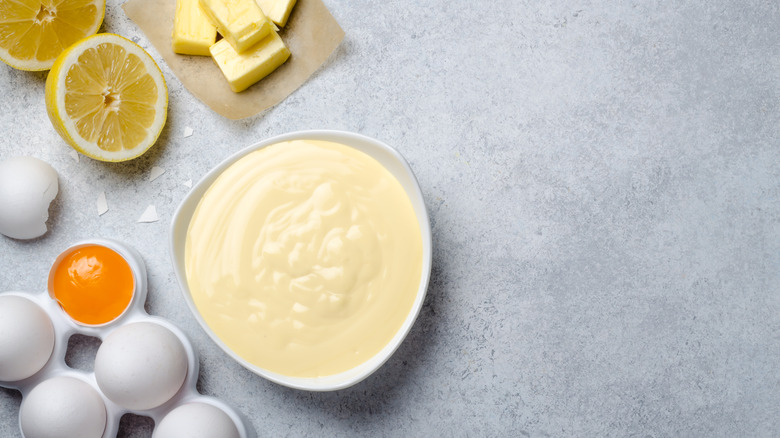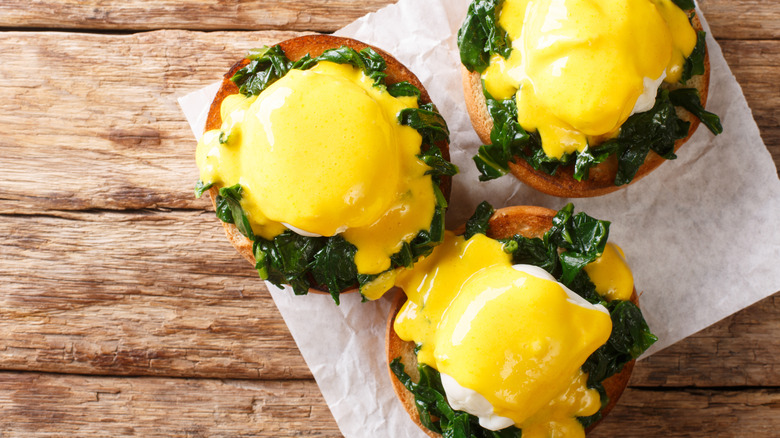The Kitchen Tool Ree Drummond Uses For A Stress-Free Hollandaise Sauce
Many ambitious cooks have tried — and sometimes failed — at making hollandaise sauce. What should be rich and creamy can often turn out oily, separated, and just plain yucky. However, Ree Drummond makes this notoriously tricky French mother sauce look like no big deal by utilizing one powerhouse countertop appliance — the blender. Diverting to this go-to machine means no need to rely on a cumbersome double boiler system, and you don't even need a whisk.
In order for Drummond's hack to work, you'll need a blender that has an insert on the lid that can be removed while the machine is running. So, bullet-style devices will not work here, though an immersion blender will still do the job. As for ingredients, all you need are egg yolks, lemon juice, and melted butter. Just blitz the yolks and lemon juice in the blender on low speed. Then, remove the insert, and carefully add in the hot melted butter a little bit at a time while the machine is running.
Temperature is an important consideration in Drummond's method, too. Since the egg yolks are not being heated up on the stove first, it's important for them to be at room temperature in the blender. Otherwise, the shock of adding hot butter to cold egg yolks may cause them to curdle. "Make sure your butter is really sizzling hot," The Pioneer Woman adds (via YouTube). This ensures that the egg yolks will be heated enough to cook thoroughly.
Why this blender hollandaise sauce works
The three simple ingredients to make hollandaise sauce — eggs, lemon juice, and butter — are bound together through a process called emulsification. This is the same method that turns mayonnaise all thick and creamy, and an oil and vinegar salad dressing into something cohesive and velvety. Basically, emulsification encourages the water found in the lemon juice and egg yolks to combine with another ingredient that is mostly fat (AKA butter). The egg yolks also have proteins that are emulsifying agents.
In a traditional method of making hollandaise sauce, the egg yolks are first slowly heated and whisked in a double boiler. The heat and manipulation denatures the proteins, which basically means that tight protein strands are encouraged to unravel. As they come apart, they become more likely to create a strong bond. When you then slowly stream in melted butter, the proteins act as a chain link between the water and fats. As you whisk, you help everything bind, and you also incorporate air, which is important to the creamy final texture.
In the blender method, the spinning blade takes the place of the whisk to break down proteins and incorporate air. This strategy also circumvents the most common mistake people make with hollandaise sauce, which is to cook it over too high a flame. When the melted butter is slowly streamed into the blender, it gently cooks the sauce in a way that is similar to the stovetop without the risk of scorching.
More hollandaise sauce tips from Ree Drummond
When you use Ree Drummond's blender method for hollandaise sauce, you will be left with a luscious, pale golden sauce with minimal stress and effort. However, if the texture is too thick for your liking, simply add in another squeeze of lemon juice or a little bit of hot water to thin it out. Drummond also likes to jazz her sauce up with additions like brown, Dijon, or Cajun spicy mustard. For a kick, she is a fan of cayenne pepper.
Of course, The Pioneer Woman enjoys hollandaise sauce as a delightful finish on traditional eggs Florentine or eggs Benedict. She also gets creative with riffs that include a base of potato cakes, smoked salmon, or an English muffin-free take that features garlicky sautéed kale, crispy bacon strips, poached eggs, and of course, her blender hollandaise sauce. She even suggests serving this creamy concoction on top of a juicy steak cooked to medium-rare. It is no wonder Drummond calls hollandaise, "my favorite sauce on Earth" (via YouTube).



